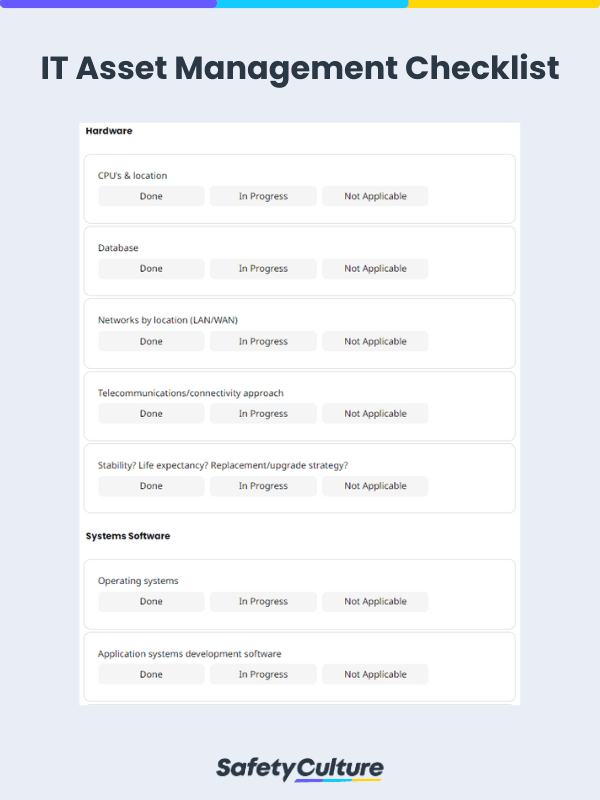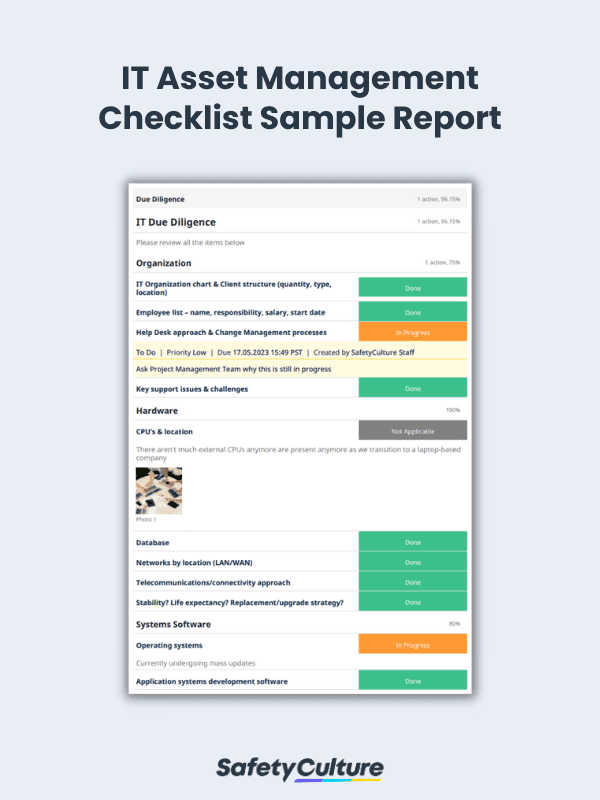What is an IT Asset Management Checklist?
An IT asset management checklist is a document that aims to help in the overall management of Information Technology (IT) assets such as hardware, software, and anything else that contributes to an organization’s systems and values. It is an essential part of ensuring the lifecycle of your assets is prolonged for as long and as efficiently as possible.
Importance and Benefits
IT asset management refers to the process of ensuring an organization’s IT assets are properly accounted for and maintained. Common IT assets that need to be managed include hardware and software for Information Security and daily operations, as well as licenses, servers, and the like.
Managing IT assets can be demanding, as there are many moving parts, hence the necessity for a checklist. An IT asset management checklist can help organize operations and their order more efficiently, as well as track the movement of people and assets more accurately.
An IT asset management checklist can also help with the following tasks:
- Schedules
- Machine calibration
- Preventive maintenance
- Reports
- History and service tracking
- Lifecycle management
Using an IT asset management checklist is also essential in conducting overall audits on IT systems.
What Should Be Included in an IT Asset Management Checklist?
A typical IT asset management checklist has sections for the following:
- Date of the audit or inspection
- Name of person conducting the IT asset management
- Status of hardware assets
- Status of software assets
- Status of ongoing projects
- Budgets and trends being monitored or followed
- Status of contracts and licenses essential to the organization
- General status of all operations at a glance
- Points for improvement in asset management and usage
- Sign-off
An asset IT asset management checklist can be done in a traditional pen-and-paper format, but it’s best to create and manage yours on a digital platform. Going digital can save you time, improving productivity and work operations. Using a digital asset management solution also helps streamline other aspects of your daily operations, as you can integrate other work software into your IT asset management tasks.
Here is a sample IT asset management checklist in use as a reference on how to use one:
Where to Use It
Asset management, by definition, covers a wide range of tasks, goals, and needs. An IT asset management checklist can thus be used for the following audits and tasks:
- Watching over the movement of your IT assets as they are used by others
- Managing hardware assets such as laptops, phones, printers, plugs, electrical wiring, and the like in order to increase efficiency and life expectancy
- Managing software assets such as digital solutions, accounting software, security providers, and the like to ensure their licenses and systems are up-to-date and still usable
- Maintaining, managing, and IT asset lifecycles, including asset acquisition, assignment, usage, upkeep, and disposal if necessary to ensure all systems are working properly as intended
- Creating, sharing, and documenting work orders and jobs done on IT assets as a whole, including but not limited to maintenance, repair, and inventory
- Documenting and reporting incidents and instances of non-compliance with certain standards and regulations
FAQs about IT Asset Management Checklist
There is usually a dedicated manager who conducts IT asset management audits. However, in some cases, other authorized personnel may manage and use the checklist, depending on organization policy.
An IT asset inventory checklist is an asset management checklist specifically designed for inventory use. Compared to an IT asset management checklist, an IT asset inventory checklist focuses more on logging an asset’s storage, location, license, purpose, sales, and other essential details.
A good IT asset management checklist can only be used efficiently if its users know how it works. Some of the best practices for using one include:
- Establishing a centralized asset management and tracking system and including it in the checklist
- Assigning unique asset identifiers before and during inspections so each IT asset can be easily identifiable and tracked
- Tracking assets wherever they may be from within your checklist




